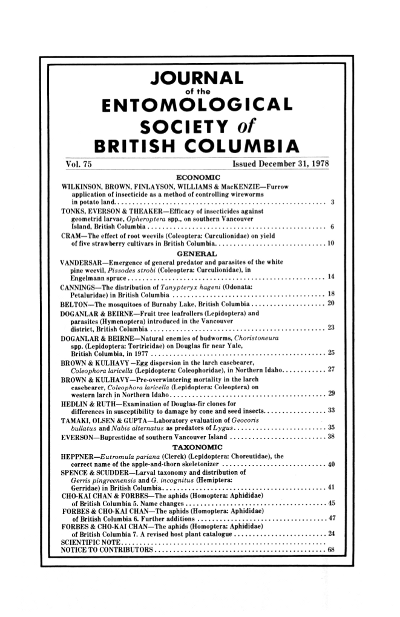Pre-overwintering mortality in the larch casebearer, <i>Coleophora laricella</i> (Lepidoptera: Coleophoridae), on western larch in Northern Idaho.
Keywords:
larch casebearer, <i>Coleophora laricella</i>, Lepidoptera, Coleophoridae, western larchAbstract
During 1976, continuous sampling of the same population cohort showed a 68% mortality in the pre-wintering larch casebearer, <i>Coleophora laricella</i>, in northern Idaho. The major mortality factors were density-independent; these were: premature needle drop caused by the needle diseases <i>Meria laricis</i> and <i>Hypodermella laricis</i> (18%); non-viable eggs (10%); and dislodgment of the eggs from the branch (10%). Other factors were: predation, desiccation, ripening and fall of the needles, intraspecific competition, loss of larvae moving between needles, and larch-willow rust.References
Baird, A.B. 1923. Some notes on the natural control of the larch sawfly and larch casebearer in New Brunswick in 1922. Acadian Ent. Soc. Proc. Nova Scotia (1922) 8:158-171.
Brown, M.W. 1976. A partial life table for the larch casebearer, Coleophora laricella (Lepidoptera; Coleophoridae) with notes on egg dispersion. M.S. thesis. Univ. of Idaho, Moscow, Idaho.
Daubenmire, R. and J.B. Daubenmire. 1968. Forest vegetation of eastern Washington and northern Idaho. Washington State Univ. Agric. Exp. Sta. Tech. Bull. 60. 104 pp.
Denton, R.E. 1972. Establishment of Agathis pumila (Ratz.) for control of larch casebearer and notes on native parasitism and predation in Idaho. U.S. Dep. Agric. For. Serv. Intermountain Forest and Range Exp. Sta. Res. Note INT-164. 6 pp.
Eidmann, H.H. 1965. Ecologic and physiologic studies on the larch casebearer, Coleophora laricella Hbn. (Eng. Transl.) Studia Forestalis Suecica. No. 32. 322 pp.
Jagsch, A. 1973. Population dynamics and parasite complex of the larch casebearer in the natural area of distribution of European larch. (Eng. Transl.) Z. angew. Ent. 73:1-42.
Jung, W. 1942. Contributions to the knowledge of the larch casebearer (Coleophora laricella Hbn.). (Eng. Transl.) Z. angew. Ent. 29:475-517.
Nicholson, A.J. 1958. Dynamics of insect populations. A. Rev. Ent. 3:107-136.
Quednau, F.W. 1967. Notes on mating, oviposition, adult longevity, and incubation period of eggs of the larch casebearer, Coleophora laricella (Lepidoptera: Coleophoridae), in the laboratory. Can. Ent. 99:397-401.
Schindler, U. 1968. Population change in a typical perennial forest pest, the larch casebearer. (Eng. Transl.) Z. angew. Ent. 61:380-386.
Sloan, N.F. 1965. Biotic factors affecting populations of the larch casebearer Coleophora laricella Hbn. in Wisconsin. (Unpub.) Ph.D. Dissertation, University of Wisconsin, Madison, Wisconsin. 193 pp.
Solomon, M.E. 1957. Dynamics of insect populations. A. Rev. Ent. 2:121-142.
Stark, R.W. 1958. Life tables for the lodgepole needle miner Recurvaria starki Free. (Lepidoptera: Gelechiidae). Proc. X Internatl. Congo Ent. (1956) 4:151-162.
Webb, F.E. 1950. The biology of the larch casebearer Coleophora laricella Hubner in New Brunswick. (Unpub.) M.S. thesis. University of Michigan, Ann Arbor, Michigan. 50 pp.
Webb, F.E. 1953. An ecological study of the larch casebearer, Coleophora laricella Hbn. (Lepidoptera: Coleophoridae). (Unpub.) Ph.D. dissertation. University of Michigan, Ann Arbor, Michigan. 210 pp.
Downloads
Published
Issue
Section
License
Authors who publish with the Journal of the Entomological Society of British Columbia agree to the following terms:
-Authors retain copyright and grant the journal right of first publication with the work simultaneously licensed under a Creative Commons Attribution License that allows others to share the work with an acknowledgement of the work's authorship and initial publication in this journal.
-Authors are able to enter into separate, additional contractual arrangements for the non-exclusive distribution of the journal's published version of the work (e.g., post it to an institutional repository or publish it in a book), with an acknowledgement of its initial publication in this journal.
-Authors are permitted and encouraged to post their work online (e.g., in institutional repositories or on their website) prior to and during the submission process, as it can lead to productive exchanges, as well as earlier and greater citation of published work (See The Effect of Open Access).


